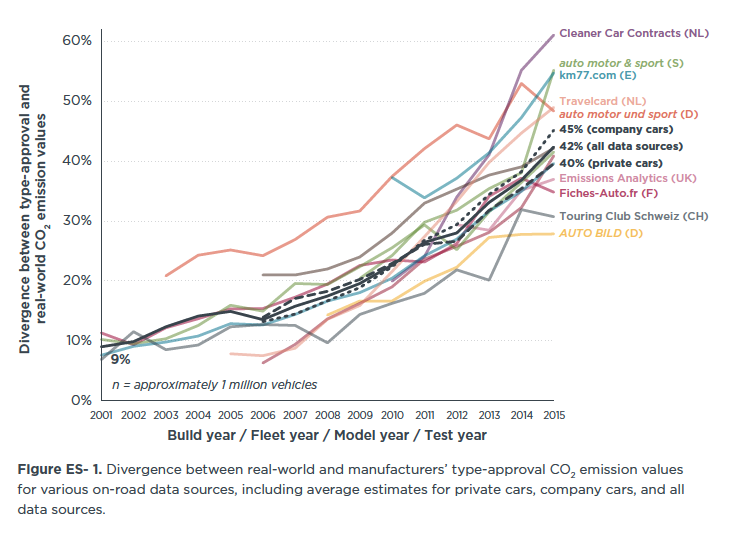Press release
[Press release] Real-world vehicle fuel consumption gap continues to widen in Europe
Discrepancy between passenger vehicle type-approval test results and in-use fuel consumption and carbon dioxide (CO2) emissions now at 42 per cent
The average gap between official fuel consumption figures and actual fuel use for new cars in the EU has reached 42 per cent, according to the latest update by the International Council on Clean Transportation (ICCT) to its on-going research into vehicle fuel consumption and CO2 emissions.
Since 2001, the discrepancy between official measurements of vehicle efficiency and actual performance of new cars in everyday driving has more than quadrupled—a discrepancy that translates into €450 per year in extra fuel costs for the average vehicle. As a result, less than half of the on-paper reductions in CO2 emissions since 2001 have been realized in practice.
The new study, jointly prepared by the ICCT and the Netherlands’ Organisation for Applied Scientific Research (TNO), describes the increasing real-world efficiency gap using systematic statistical analysis. “We analyzed data for approximately one million vehicles from seven European countries, and all data sources confirm that the gap between sales-brochure figures and the real world has reached another all time high,” said Uwe Tietge, a researcher at ICCT Europe and lead author of the study. “When we published our first study in 2013, the gap had widened over ten years from roughly 10 per cent to around 25 per cent. Now it has increased to 40 per cent for private cars, and 45 per cent for company cars.”
The analysis draws on data from 13 different sources: the user websites spritmonitor.de (Germany), honestjohn.co.uk (United Kingdom) and Fiches-Auto.fr (France), the leasing car service providers Travelcard (Netherlands), LeasePlan (Germany), Allstar (United Kingdom) and Cleaner Car Contracts (Netherlands), the car and consumer magazines AUTO BILD (Germany), auto motor sport (Germany and Sweden), WhatCar? (United Kingdom), km77.com (Spain) and the car club TCS (Switzerland).
“About three quarters of the gap between laboratory test results and real-world driving is explained by vehicle manufacturers exploiting loopholes in the current regulation,” summarizes Dr. Peter Mock, Managing Director of ICCT Europe. For example, manufacturers can decide to specially prepare the vehicle’s tires for testing or to fully recharge the vehicle’s battery before testing—measures that are not forbidden by regulation, but at the same time are not representative of real-world driving. Another quarter of the gap is explained by the deployment of technologies that have a greater effect on fuel consumption during laboratory testing than under real-world driving conditions, such as stop-start technology, and by ensuring that options that tend to increase fuel consumption—such as running the vehicle’s air conditioning— are turned off during laboratory testing.
Manufacturers measure vehicle fuel consumption in a controlled laboratory environment, using a test procedure called the New European Driving Cycle (NEDC). This procedure was developed in the 1980s and was not originally intended to be used for fuel consumption testing. A new and more appropriate test procedure, the Worldwide Harmonized Light Vehicles Test Procedure (WLTP), has been developed through the United Nations and will be implemented in the EU from 2017 onwards.
“The WLTP will cut the gap approximately in half but it contains new loopholes that could lead to the performance gap to increase again in the future,” concludes Dr. Mock. “Further actions are therefore required, in particular on-road testing of fuel consumption and CO2 emissions under real driving conditions as well as independent surveillance testing of actual vehicles on the road.”
From laboratory to road – A 2016 update of official and “real-world” fuel consumption and CO2 values for passenger cars in Europe (PDF download)
Contact: Dr. Peter Mock, Managing Director ICCT Europe, +49 (30) 847129-102, peter@theicct.org
Other contacts on the subject
Netherlands’ Organisation for Applied Scientific Research (TNO)
Dr. Norbert Ligterink
+31 (0) 888 668 058
norbert.ligterink@tno.nl
The European Consumer Organisation (BEUC)
Ms. Chris Carroll
+32 (0) 2 789 2754
Chris.Carroll@beuc.eu
Federation International de l’Automobile (FIA) (car clubs’ association)
Ms. Laurianne Krid
+32 (0) 2 282 0818
lkrid@fia.com
European Automobile Manufacturers Association (ACEA)
Mr. Petr Dolejsi
+32 2 738 7357
pd@acea.be
Transport Environment (T&E) (NGO umbrella organisation)
Mr. Greg Archer
+32 2 893 0849
greg.archer@transportenvironment.org

